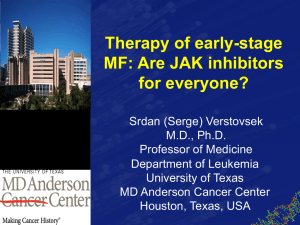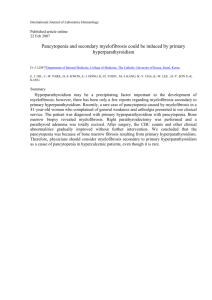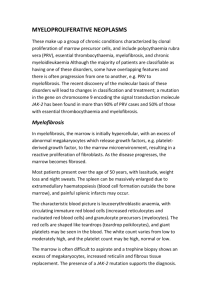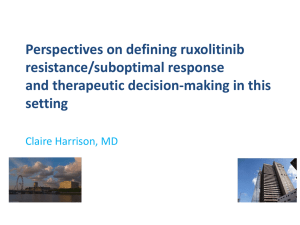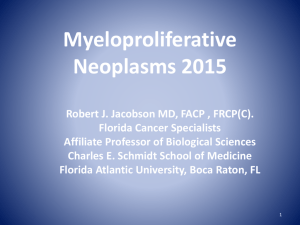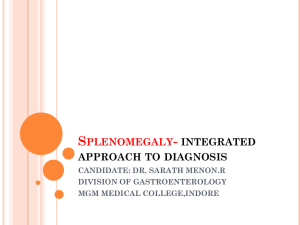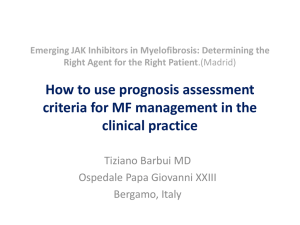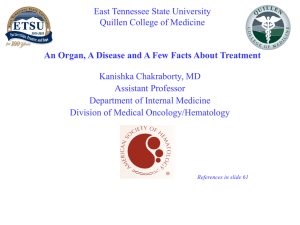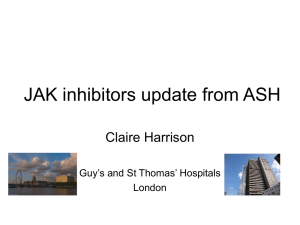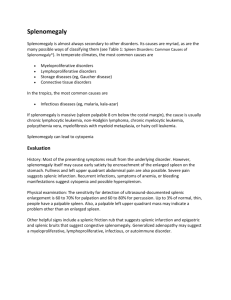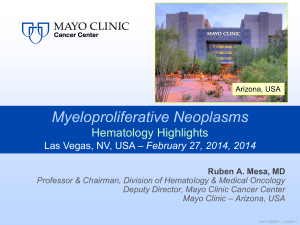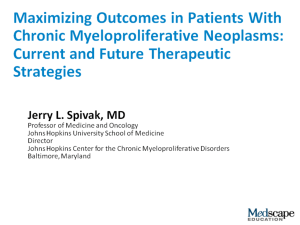PowerPoint **
advertisement
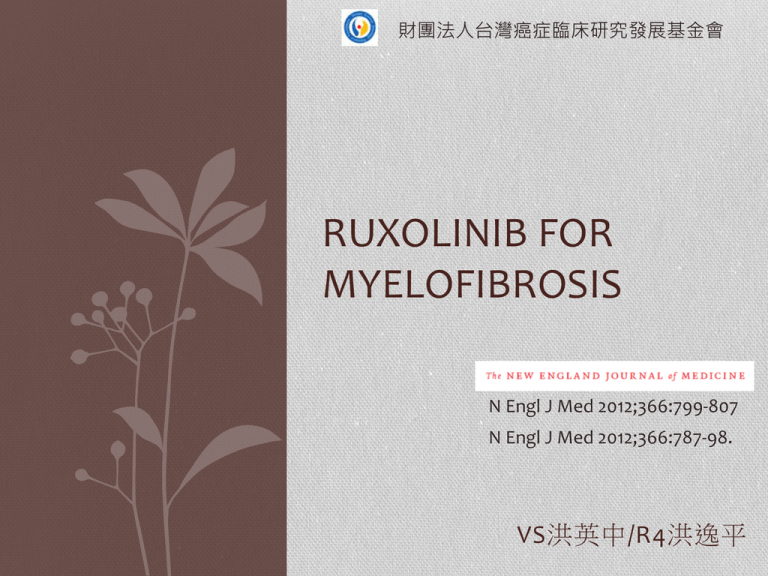
財團法人台灣癌症臨床研究發展基金會 RUXOLINIB FOR MYELOFIBROSIS N Engl J Med 2012;366:799-807 N Engl J Med 2012;366:787-98. VS洪英中/R4洪逸平 Myelofibrosis • Epidemiology • Mainly in middle aged and elder patients, the median age at presentation is 67 y/o • Clinical Manifestation • Constitutional symptoms • Weight loss 10% of baseline in the year • Unexplained fever • Excessive sweats persisting for 1 month • • • • • Splenomegaly Hepatomegaly Extramedullary hematopoiesis Thrombotic events Bone and joint involvement Cause of Bone Marrow Fibrosis Primary Myelofibrosis • Major Criteria • Atypical megakaryocytic hyperplasia, often accompanied by reticulin and/or collagen fibrosis or in the absence of fibrosis, megakaryocytic atypia and marrow hypercellularity with myeloid hyperplasia and erythroid hypoplasia • Exclusion of WHO criteria for PV, CML, MDS, or other MPDs • JAK2V617F mutation or other clonal marker or if no clonal marker, exclusion of marrow fibrosis secondary to inflammatory or other neoplastic disorders • Minor Criteria • • • • Leukoerythroblastosis Elevated serum lactate dehydrogenase level Anemia Palpable splenomegaly Pathogenesis of myelofibrosis Somatic mutations in classic MPD including primary myelofibrosis, PV and ET Somatic mutations in classic MPD including primary myelofibrosis, PV and ET The Dynamic International Prognostic Scoring System (DIPSS) • • complex karyotype 1 or 2 abnormalities that include +8, 7/7q, i(17q), inv(3), 5/5q 12p, or 11q23 rearrangement • • • Weight loss 10% of baseline in the year Unexplained fever Excessive sweats persisting for 1 month The Dynamic International Prognostic Scoring System (DIPSS) BLOOD, 31 MARCH 2011 VOLUME 117, NUMBER Prognosis based on DIPSS Overall Survival 16 35 78 Leukemia-free survival 185 J Clin Oncol 29:392-397 Treatment Option • Low- or intermediate 1–risk disease • Asymptomatic: Watch and Wait • Symptomatic: Conventional drug therapy is indicated • Intermediate 2– or high-risk disease • Conventional drug therapy • Splenectomy • Radiotherapy • Allo-SCT • Experimental drug therapy Drug Respons e Rate Duration Erythropoiesisstimulation Factor (DPO) < 56% 1 year Effect Adverse Effect Special consideration Drug-induced exacerbation of splenomegaly Symptomatic anemia, not transfusion dependent, serum EPO<125 Corticosteroid 20% (0.5mg/kg/d) 1 year Androgen(flu oxymesteron e 10mg tid) 20% 1 year Danazole(600 mg/d) 20% 1 year Thalidomide(5 20% 0mg/d) 1 year Anemia, thrombocytopeni a, and splenomegaly Peripheral neuropathy May add with steroid Lenalidomide( 20% 10mg/d) 1 year Response in Anemia and splenomegaly neutropenia or thrombocytop enia Favored in Del(5q) May add aspirin Hydroxyurea 1 year Splenomegaly Myelosuppresion, Response lower in xeroderma, JAK2V617F(-) mucocutaneous ulcers 35% hepatotoxicity and virilizing effects Splenectomy • Indication: • • • • • • drug-refractory symptomatic splenomegaly severe discomfort or pain, frequent red blood cell transfusions, severe thrombocytopenia, symptomatic portal hypertension, profound cachexia • Response rate: >50% • Duration: 1 year • Perioperative mortality rate: 5-10%, Morbidity rate: 25% • Leukemia transformation: Indeterminate Radiotherapy • Indication: • non–hepatosplenic EMH, • vertebral column (spinal cord compression), • lymph nodes (lymphadenopathy), • pleura (pleural effusion), • peritoneum (ascites), • skin(cutaneous nodules) low-dose radiotherapy (100-500 cGy in 5-10 fractions). • pulmonary hypertension single-fraction (100 cGy) whole-lung irradiation • lower or upper extremity pain Single fraction of 100-400 cGy Allogeneic stem cell transplantation • The only treatment option in MF that is capable of inducing complete hematologic, cytogenetic, and molecular remissions. Study Case Duprez score Regimen 3-y OS Recurrence rate Non-relapse mortality rate Extensive GVHD Stewart WA et al in UK 51 pts, low:24%, intermedia te:33%, High:43% CIC(conventio nal-intensity) 44% 15% 41% 30% RIC(reduced intensity) 31% 46% 32% 35% Allogeneic stem cell transplantation Study Case Duprez score Treatment related mortality 5-y OS 3-year DFS Ballen KK et al, 289 pts, USA Low:32% Intermediate: 36% High: 31% 1 year:27% 5 year:35% 37% 39% 1 year:43% 5 year:50% (unrelated donor) 30% 17% Francesca 100 pts Patriarca et al, Low:10% Italy Int.:58% High:32% 1 year:35% 3 year:43% 31% 35% Myelofibrosis Treatment Algorithm BLOOD, 31 MARCH 2011 VOLUME 117, NUMBER 13 JAK inhibitors in Clinical Trial Putative Mechanisms of Disease and Drug Action of JAK Inhibitors in Myelofibrosis Ruxolitinib (INCB018424) • Potent inhibitor of JAK1 and JAK2 • Had durable reduction in splenomegaly and improve myelofibrosis related symptom • Related Trial: • the Controlled Myelofibrosis Study with Oral JAK Inhibitor Treatment I(COMFORT-I) • the Controlled Myelofibrosis Study with Oral JAK Inhibitor Treatment II (COMFORT-II) Compare the current 2 trial in NEJM COMFORT-I (n=309) COMFORT-II (n=219) Initiater Srdan Verstovsek et al in the US Claire Harrison et al in the UK Inclusion criteria >18y/o Primary myelofibrosis Post-PV MF Post-ET MF IPSS ≧ 3 (int. 2 and high risk) ECOG ≦ 3 Peripheral blast < 10% plt > 100k palpable splenomegaly(≥5 cm below the left costal margin) >18y/o Primary myelofibrosis Post-PV MF Post-ET MF IPSS ≧ 3 (int. 2 and high risk) ECOG ≦ 3 Peripheral blast < 10% plt > 100k palpable splenomegaly(≥5 cm below the left costal margin) Study design Double blind Randomly assigned, 1:1 ratio Ruxotinib/placebo Crossover to Ruxotinib was permitted if splenomegaly worsening Randomly assigned, 2:1 ratio Ruxolitinib/ Best available therapy The best available treatment group may shift to Ruxotinib group if spleen volume > 25% Drop out criteria Primary End Leukemic transformation or splenic irradiation reduction of 35% or more in spleen reduction of 35% or more in spleen Result COMFORT-I(n=309) Spleen Size Ruxolitinib: 41.9% at week 24 (reduction>35%) Placebo: 0.7% at week 24 Biomarkers Ruxolitinib JAK2V617F allele burden -10.9% at week 24 -21.5% at week 48 Reduction in CRP, TNF-alpha, IL-6 Increase in leptin, erythropoietin Placebo JAK2V617F allele burden 3.5% at week 24 6.3% at week 48 Overall Survival At median F/u 51 weeks 13 deaths in Ruxolitinib(8.4%) 24 deaths in placebo(15.6%) Hazard ratio: 0.50, p=0.04 COMFORT-II (n=219) 32% at week 24, 28% at week 48 0% at week 24, 0% at week 48 Reduction in CRP, IL-6, TNF-alpha Increase in leptin, erythropoietin At 12 months f/u 6 deaths in Ruxoliinib (4%) 4 deaths in best.. Group (5%) Hazard ratio: 0.7 (95% CI 0.20-2.49) Spleen Size COMFORT-I COMFORT-II COMFORT-I COMFORT-II Overall Survival COMFORT-I COMFORT-II • At 12 months f/u • 6 deaths in Ruxoliinib (4%) • 4 deaths in best.. Group (5%) • Hazard ratio: 0.7 (95% CI 0.20-2.49) No survival benefit! Side Effect Discussion • Ruxolitinib resulted in a rapid reduction of splenomegaly, which was observed at week 8 and continued through week 48 • Ruxolitinib also resulted in change of cytokine levels • Ruxolitinib was associated with increased frequencies of anemia and thrombocytopenia • Response rate was higher in JAK2 V617F positive group (33%:14%) • The minimal benefit to survival in COMFORT-II may be due to 25% patient in the best available treatment group crossover to Ruxolitinib group and 12% withdrawn consent. However, OS benefit is noted in COMFORT-I Take Home Message • Myelofibrosis is a disease of bone marrow fibrosis, manifested as splenomegaly, fatigue, extramedullary hematopoiesis, and thrombotic events • Treatment includes: • • • • • Conventional drugs, Splenectomy Radiotherapy Allo-SCT New drugs • Ruxolitinib is a JAK1 and JAK2 inhibitor • Ruxolitinib is effective on reduction of spleen size, improve the symptoms and quality of life, however OS indeterminate Thanks for Your Attention!!
